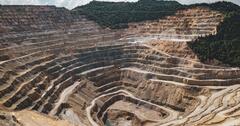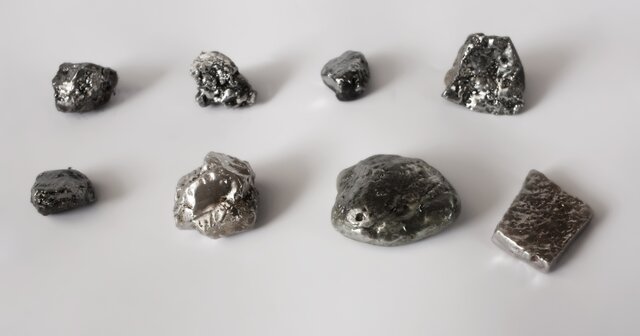

China’s new export restrictions on rare earths show one of the many ways decarbonization policies are disadvantaging our economy and threatening our national security. A wind, solar, and battery-powered future America would be heavily reliant on China. Decarbonization would disadvantage our economy and threaten our national security.
The People’s Republic of China announced export restrictions on seven rare earths: scandium, yttrium, samarium, gadolinium, terbium, dysprosium, and lutetium. These restrictions, imposed in early April, underscore a key weakness in policies that aim to eliminate carbon emissions in the United States: Across the supply chains for net-zero technologies, China holds a dominant position.
Wind turbines require steel, concrete, fiberglass, and carbon fiber for the structure of the turbine and its blades, while copper and various rare earth elements are used for the magnets and the wiring needed to generate electricity. China has an effective lock on these rare earths, with about 34% of the world’s proven reserve of rare earth oxides. That’s almost twenty times more than the United States, according to the U.S. Geological Survey.
“China dominates each of the major stages in the supply chain” for the main magnets used in wind turbines, the Department of Energy notes. “Even more significantly, this concentration of production in China increases at every downstream stage, rising from a 58% share of annual global rare earth mining in 2020 to a 92% share of annual global magnet production.”
As of 2022, China was responsible for 70% of rare earth minerals mining. America’s one and only rare earth mine sends its materials to China for processing.
Solar panels are primarily made up of glass and silicon. They also contain polymers, aluminum, copper, and silver. Polysilicon is produced from refined silicon, and 93% of its global production capacity is located in China.
Utility-scale battery systems predominantly consist of lithium-ion batteries, which use lithium, graphite and cobalt. These are the types of batteries used in most electric vehicles. China holds about 60% of global lithium processing capacity, the world’s largest graphite reserves (with nearly a third of the world’s graphite and around 77% of global production), and three-quarters of global cobalt refining capacity.
Given that the Chinese Communist Party has declared rare earths to be the property of the state, has recently limited rare earth exports and outright banned the export of critical minerals like gallium, antimony, and germanium to the United States, it appears that the move toward wind, solar, and battery power puts America’s energy fate in the CCP’s hands.
First question: Can the United States source its net zero dreams at home?
Just because China now dwarfs American production of all the materials for net zero projects doesn’t necessarily mean the United States couldn’t ramp up. Theoretically, we could invest in building domestic supply chains for wind, solar, and battery materials, right?
America’s only active rare earth mine, Mountain Pass, sits in California’s Clark Mountain Range and currently provides 15% of the world’s rare earth production.
For new mining prospects, environmental regulations — somewhat ironically — stand in the way of strengthening the decarbonization supply chain. Permitting a mine in the United States takes five times longer than it does in Canada or Australia; mining projects take longer and longer to start production, with the average American mine’s lead time sitting at almost 13 years. Multiple copper and nickel mines are still held up in the permitting process. While future mines like Wyoming’s Halleck Creek/Cowboy State Mine, Montana’s Sheep Creek Mine, and Nebraska’s Elk Creek Project are located in development-friendly states, they still appear likely to face environmental opposition.
Imagining that such environmental opposition could magically go away, the next question remains: Should the U.S. use rare earths for net zero projects?
Short answer: No.
Wind, solar, and batteries are an inefficient and erratic way to power an electric grid.
After a few decades of effort, we could begin to rival China and take control of the supply chain and manufacturing process for electric vehicles and alternative energy. But why? To develop a grid destabilized by weather-dependent wind and solar to power cars that most Americans don’t want?
If we boost American rare earth production, those materials shouldn’t be wasted on subsidy-dependent wind and solar industries. Instead, they should be directed toward products American consumers want–computers, phones and possibly a few electric vehicles.
Trying to scale up American production for net zero technologies is competing to win a game we shouldn’t bother playing.
Permission to reprint this blog post in whole or in part is hereby granted, provided that the author (or authors) and the Mackinac Center for Public Policy are properly cited.
Get insightful commentary and the most reliable research on Michigan issues sent straight to your inbox.

The Mackinac Center for Public Policy is a nonprofit research and educational institute that advances the principles of free markets and limited government. Through our research and education programs, we challenge government overreach and advocate for a free-market approach to public policy that frees people to realize their potential and dreams.
Please consider contributing to our work to advance a freer and more prosperous state.

Donate | About | Blog | Pressroom | Publications | Careers | Site Map | Email Signup | Contact